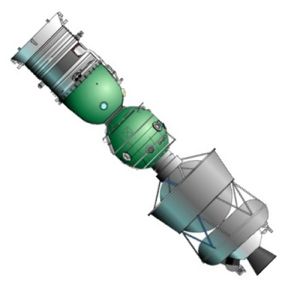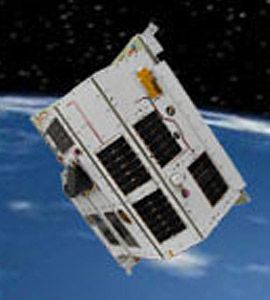
Home - Search - Browse - Alphabetic Index: 0- 1- 2- 3- 4- 5- 6- 7- 8- 9
A- B- C- D- E- F- G- H- I- J- K- L- M- N- O- P- Q- R- S- T- U- V- W- X- Y- Z
DSE-Alpha
 DSE-Alpha Circumlunar Soyuz-Block DM Tourism Spacecraft Credit: © Mark Wade |
AKA: Soyuz Circumlunar. Status: Study 2005. Gross mass: 25,000 kg (55,000 lb).
The customer would be shot around the moon as early as 2008 at a price of $100 million. Soyuz had already been proven for this role under the L1 program in the 1960's.
In August 2005 Energia, in collaboration with Space Adventures / Deep Space Expeditions announced the potential offering of flights around the moon to millionaires able to afford the $ 100 million price tag. Dusting off the work of the 1960's that resulted in the Soyuz being qualified for manned circumlunar flight, the new version proposed two mission profiles:
The baseline Direct Staged Mission would run as follows:
- Day 1: Launch of a Soyuz TMA spacecraft by a Soyuz 11A511U booster into low earth orbit.
- Day 2: Launch of Block DM upper stage by a Zenit-3 launch vehicle. After the Block DM's parking orbit parameters were verified, the Soyuz TMA began to maneuver to rendezvous with the upper stage.
- Day 3: The Soyuz docked with the Block DM. After check-out, the Block DM fired to propel the Soyuz on a trans-lunar trajectory. After burn-out, the Soyuz undocks from the upper stage and continues on its ballistic course toward the moon.
- Days 4-5: Coast to the moon. The Soyuz makes mid-course maneuvers as necessary.
- Day 6: Loop around the moon at a considerable altitude. The Soyuz did not have the propellant capacity to enter lunar orbit, so the surface passed by below in an encounter of just a few hours.
- Days 7-8: The long fall back towards earth, with midcourse corrections as needed.
- Day 9: Re-entry in the earth's atmosphere. Presumably the Soyuz would make the double-dip trajectory over one of the earth's poles perfected by the L1 Zond spacecraft in the 1960's.
For the L1 circumlunar program of the 1960's, Korolev sold the idea based on a single Proton booster launch. This would orbit a Block D upper stage with an L1 manned spacecraft (a stripped Soyuz). After a time in parking orbit, the Block D would fire to send the L1 around the moon. Later his design bureau developed the podsadka alternative. First the Proton would boost an unmanned Block D and L1 into low earth orbit. Then an orbital version of Soyuz would be launched separately on an 11A511U booster and rendezvous and dock with the L1/Block D in orbit. Then the crew for the L1 would transfer form the Soyuz, the Soyuz would undock, the Block D would fire to send the L1 toward the moon. It would have been simpler to follow the 2005 scenario - orbit a Block D with a docking collar, then have the Soyuz launch separately, dock with the Block D, and set off for the moon. Evidently there was no time during the space race to modify the Block D to handle the extra propellants required for such a scenario.
A quick calculation shows that such a mission was right at the edge of the capability of the described spacecraft. A fully-fuelled Block DM, fitted with a docking collar and avionics, would be well beyond the payload capacity of the Zenit two-stage booster for the mission described. The Block DM would have to fire briefly after separation form the Zenit-2 second stage to put itself into parking orbit. The Soyuz itself (presumably with a two-man crew) would have to be lightened by several hundred kilograms from its basic orbital version.
The DSE-Alpha mission was just the first and easiest possibility, a kind of test of the market. Presumably subsequent Lunar Orbit or Lunar Landing flights would be designated DSE-Beta and DSE-Gamma...
Crew Size: 2.
Family: Lunar Flyby, Manned Circumlunar, Moon. Country: Russia. Agency: Korolev bureau, Space Adventures. Bibliography: 1998, 6463.
 | DSE 1 Credit: Manufacturer Image |
Back to top of page
Home - Search - Browse - Alphabetic Index: 0- 1- 2- 3- 4- 5- 6- 7- 8- 9
A- B- C- D- E- F- G- H- I- J- K- L- M- N- O- P- Q- R- S- T- U- V- W- X- Y- Z
© 1997-2019 Mark Wade - Contact
© / Conditions for Use